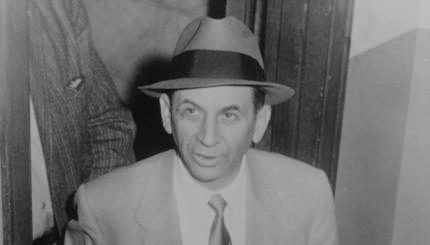There are few excuses for the behavior of Jewish gangsters in the 1920s and 1930s. The best known Jewish gangsters –Meyer Lansky, Bugsy Siegel, Longy Zwillman and Moe Dalitz — participated in the numbers rackets, illegal drug dealing, prostitution, gambling and loan sharking. They were not nice men. During the rise of American Nazism in the 1930s and when Israel was being founded between 1945 and 1948, however, they proved staunch defenders of their people.
The roots of Jewish gangsters lay in the ethnic neighborhoods of the Lower East Side; Brownsville, Brooklyn; Maxwell Street in Chicago; and Boyle Heights in Los Angeles. Like other newly arrived groups in American history who were blocked from access to respectable professions, a few Jews used crime as a means to “make good” economically. The market for vice flourished during Prohibition, and Jews exploited the illegal market created by the bans on alcohol, gambling, paid sex and narcotics.
Few of these men were religiously observant. They rarely attended services, although they did support congregations financially. They did not keep or send their children to day schools. However, at crucial moments, they protected other Jews in America and around the world.
Breaking Up American Nazi Rallies in the 1930s
The 1930s in America were a period of rampant anti-Semitism, particularly in the Midwest. Father Charles Coughlin, Detroit’s “Radio Priest,” and William Pelley of Minneapolis, openly called for Jews to be driven from positions of responsibility, if not from the country itself. Organized Brown Shirts in New York and Silver Shirts in Minneapolis both outraged and terrorized American Jewry. While the older and more respectable Jewish organizations pondered a response that would not alienate non-Jewish supporters, others — including rabbis — asked the gangsters to break up American Nazi rallies.

Help us keep Jewish knowledge accessible to millions of people around the world.
Your donation to My Jewish Learning fuels endless journeys of Jewish discovery. With your help, My Jewish Learning can continue to provide nonstop opportunities for learning, connection and growth.
Historian Robert Rockaway notes that German-American Bund rallies in the New York City area posed a dilemma for mainstream Jewish leaders. They wanted the rallies stopped but had no legal grounds on which to do so. New York State judge Nathan Perlman personally contacted Meyer Lansky and asked him to disrupt the Bund rallies, provided that Lansky’s henchmen stopped short of killing any Bundists. Enthusiastic for the assignment if disappointed by the restraints, Lansky accepted all of Perlman’s terms except for one: he would take no money for the work. Lansky later observed, “I was a Jew and felt for those Jews in Europe who were suffering. They were my brothers.” For months, Lansky’s workmen effectively broke up one Nazi rally after another. As Rockaway notes, “Nazi arms, legs, and ribs were broken, and skulls were cracked, but no one died.”
Lansky recalled breaking up a Brown Shirt rally in the Yorkville section of Manhattan:
The stage was decorated with a swastika and a picture of Hitler. The speakers started ranting. There were only 15 of us, but we went into action. We … threw some of them out the windows…Most of the Nazis panicked and ran out. We chased them and beat them up…We wanted to show them that Jews would not always sit back and accept insults.
In Minneapolis, William Dudley Pelley organized a Silver Shirt Legion to “rescue” America from an imaginary Jewish-Communist conspiracy. In Pelley’s own words, just as “Mussolini and his Black Shirts saved Italy and as Hitler and his Brown Shirts saved Germany,” he would save America from Jewish communists. Minneapolis gambling czar David Berman confronted Pelley’s Silver Shirts on behalf of the Minneapolis Jewish community.
Berman learned that Silver Shirts were mounting a rally at a nearby Elks’ Lodge. When the Nazi leader called for all the “Jew bastards” in the city to be expelled, or worse, Berman and his associates burst in to the room and started cracking heads. After ten minutes, they had emptied the hall. His suit covered in blood, Berman took the microphone and announced, “This is a warning. Anybody who says anything against Jews gets the same treatment. Only next time it will be worse.” After Berman broke up two more rallies, there were no more public Silver Shirt meetings in Minneapolis.
Helping the Haganah in Pre-State Israel
Jewish gangsters also helped establish Israel after the war. One famous example is a meeting in 1945 between Bugsy Siegel and Reuven Dafne, a Haganah (precursor of the Israel Defense Forces) emissary. Dafne was seeking funds and guns to help liberate Palestine from British rule. A mutual friend arranged for the two men to meet. “You mean to tell me Jews are fighting?” Siegel asked. “You mean fighting as in killing?” Dafne answered in the affirmative. Siegel replied, “I’m with you.” For weeks, Dafne received suitcases from Siegel filled with $5 and $10 bills–$50,000 in all.
No one should paint gangsters as heroes. They committed acts of great evil. Rockaway has presented a textured version of Jewish gangster history in a book titled, But He Was Good to His Mother. One might add that, despite their disreputable behavior, they could sometimes be good to their people, too.
Chapters in American Jewish History are provided by the American Jewish Historical Society, collecting, preserving, fostering scholarship and providing access to the continuity of Jewish life in America for more than 350 years (and counting). Visit www.ajhs.org.


